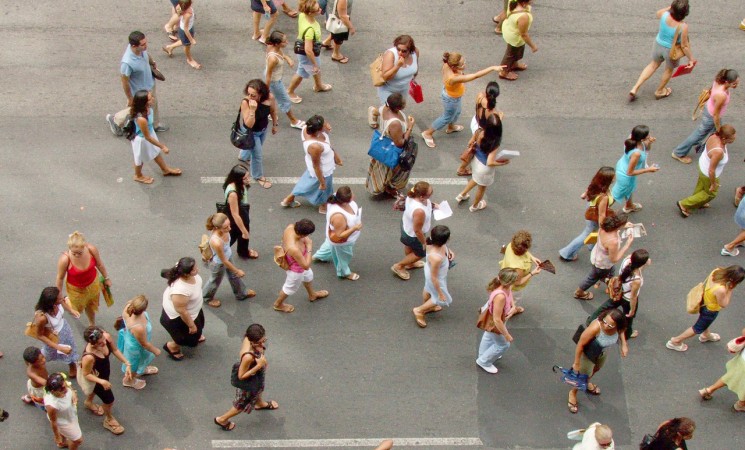Archived Content
This page is archived and provided for historical reference. The content is no longer being updated, and some of the information may have changed over time and could be outdated or inaccurate.

By Yong Yang, Ph.D.
Recently, numerous empirical studies have been published on utilitarian walking as a travel mode due to the benefits of walking on physical and mental health, as well as its potential to decrease air pollution and traffic congestion and to promote sustainable urban development and social cohesion in neighborhoods.
Simultaneously, a number of conceptual frameworks have been proposed that focus on physical activity in general, active travel including walking and bicycling, or, more specifically, on children’s travel to school. Most of these frameworks are extensions of theories, including utility theory, the theory of planned behavior (TPB), or the social-ecological model. Substantial progress has been made towards the understanding of how a travel mode is chosen (by walking or not), especially the incorporation of psychological properties and multiple factors at multiple levels.
However, one major problem for most frameworks is the lack of dynamic processes by which the behavior (specifically, utilitarian walking), attitude and habit, and environment are directly or indirectly shaped. Another problem is that most frameworks, especially those based on social-ecological models, are not operation-oriented.
Our understanding of how an empirical intervention may increase utilitarian walking (and overall physical activity) is limited, and research on health behaviors has shown that interventions based on theoretical frameworks or theoretical constructs are more effective. Indeed, we need frameworks at the conceptual and operational levels to provide indications for theoretical research and policy interventions. Besides, theories may be complementary to each other, and we believe that the combination of various theories and frameworks, together with the accumulated evidence from empirical research, provide a knowledge foundation on which a more comprehensive framework could be based.
Study proposes an integrated conceptual framework for travel mode choice focusing on utilitarian walking
In a paper published in the Journal of Transport & Health, I identified and reviewed 22 frameworks related to travel mode choice/utilitarian walking through the combination of manual pick-up, peer recommendation, and a non-comprehensive. Then, I proposed an integrated conceptual framework for travel mode choice focusing on utilitarian walking (see Figure. 1 in the paper).
The basic constructs in the travel mode choice functions are utilities, constraints, attitude, and habit. The travel mode choice function follows a hierarchical structure and heuristics rules and is influenced directly or indirectly by a number of dynamic processes, including perception of the environment, attitude formation processes, habit formation process, interaction among an individual’s own behaviors, interaction among travelers, feedback from travel to the built and social environments (i.e., interaction between individuals and the environment), and feedback from other behaviors (e.g., change of residence and auto ownership) to the built and social environments.
We need longitudinal study designs using time-series data to investigate causal relationships
This framework has two unique values. First, this framework is based on the integration of utility theory, the TPB, and the social-ecological model. Second, the framework is dynamic and includes a number of feedback loops. The framework may contribute to the study design, data collection, adoption of new research methods, and provide indications for policy interventions. For example, we need longitudinal study designs using time-series data to investigate causal relationships. Novel research methods such as agent-based modeling (ABM), can be used complementarily with statistical analysis at the operational level. Dynamic processes and causal relationships could be explicitly implemented in an ABM to test hypotheses, make predictions, or explore policy interventions. More important, although this framework is for the travel mode choice, with considerable modifications it may be applied to other health behaviors involving decision-making and interactions with the environment.
Support
This research was funded by the National Heart, Lung and Blood Institute (grants R21-HL106467 and R01-HL071759). I would like to thank my collaborators including Ana Diez-Roux, Amy Auchincloss, Daniel Rodriguez, Daniel Brown, and Rick Riolo. Although they have not made contributions directly, the paper was inspired and benefited from our collaborations on related projects.
About the Author
 Dr. Yong Yang is an assistant professor at the School of Public Health at the University of Memphis. He received his doctorate in health geography in 2007 from the University of Southampton. After several years working as post-doctoral research fellow and research faculty at the University of Michigan and Drexel University, he started his faculty position at The University of Memphis. His research area is urban environmental health, focusing on the relationship between urban environment and health behavior. His research methodology is the integration of system science methods especially agent-based modeling, statistical analysis, spatial analysis, and geographical information systems. Dr. Yang has more than 10 years’ experience in the application of agent-based modeling for public health, and examples include modeling adults’ daily walking, children's active travel to school, infectious disease transmission, and the modeling the dynamic interaction between health, income, and environment at the neighborhood level. For more on Dr. Yang’s his research, please visit his profile.
Dr. Yong Yang is an assistant professor at the School of Public Health at the University of Memphis. He received his doctorate in health geography in 2007 from the University of Southampton. After several years working as post-doctoral research fellow and research faculty at the University of Michigan and Drexel University, he started his faculty position at The University of Memphis. His research area is urban environmental health, focusing on the relationship between urban environment and health behavior. His research methodology is the integration of system science methods especially agent-based modeling, statistical analysis, spatial analysis, and geographical information systems. Dr. Yang has more than 10 years’ experience in the application of agent-based modeling for public health, and examples include modeling adults’ daily walking, children's active travel to school, infectious disease transmission, and the modeling the dynamic interaction between health, income, and environment at the neighborhood level. For more on Dr. Yang’s his research, please visit his profile.
Photo Credits: Freeimages.com/Marcelo Moura








